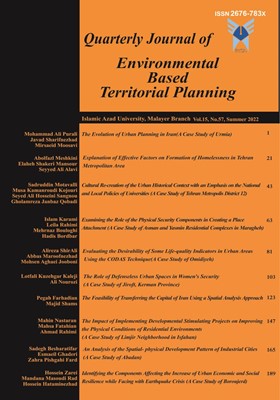The Role of Defenseless Urban Spaces in Women's Security
(A Case Study of Jiroft, Kerman Province)
Subject Areas :
Lotfali Kozegar Kaleji
1
*
,
Ali Nourozi
2
1 - Associate Professor, Department of Geography & Spatial Planning, Shahid Beheshti University, Tehran, Iran
2 - , Master of Public Administration, Islamic Azad University
Received: 2020-05-04
Accepted : 2020-08-08
Published : 2022-08-23
Keywords:
Jiroft,
defenseless space,
women's security,
Abstract :
The growing trend of urban development and the fundamental changes in the body structure of cities have made it imperative to pay attention to the quality of urban spaces. The low level of quality of space, which is considered an unprotected space, is strongly influenced by the security of citizens and especially vulnerable groups such as women. In this regard, this study emphasizes the role of unprotected spaces in Jiroft, to assess the extent of its relationship and its impact on women's security. The necessary data were collected using a questionnaire. Using the independent t-test, Kendal's correlation and regression, first, the quality of urban spaces and then its relationship and its impact on women's safety were determined. The results of the study, which were extracted from a sample of 383 people, show that nine quality indicators of space with a score of 2.7 are lower than the average of 3, which indicates the development of defenseless spaces in the city of Jiroft. Also, the relationship between unprotected spaces and women's security can be confirmed with a coefficient of 0.577 and an error level of 0.000. Finally, using the regression test, the effect of women's security on these spaces with a correlation coefficient of 0.655 and an impact level of 41% indicates the effect of independent variables on dependent variables. It can be stated that due to the dissatisfaction of women with the quality of urban spaces and the positive relationship between these spaces and the level of security, it is necessary to review urban design, especially in marginal areas.
References:
:
تاجران، ع.، کلاکی، ح. 1388. بررسی تأثیر عملکرد پلیس بر احساس امنیت شهروندان تهرانی، فصلنامه مطالعات مدیریت انتظامی، 4(4)، 581-561.
مرکز آمار ایران. 1395. سرشماری عمومی نفوس و مسکن، سرفصل جمعیت استان کرمان.
شادنیا، ه. 1382. قاچاق کالا و امنیت اجتماعی، مجموعه مقالات همایش امنیت اجتماعی، جلد دوم، معاونت اجتماعی ناجا.
کارگر، ب.، سرور، ر. 1392. شهر، حاشیه و امنیت اجتماعی.چاپ اول. انتشارات سازمان جغرافیایی نیروهای مسلح. 540 صفحه.
ملکی, ی. 1395. شهر و امنیت اجتماعی از منظر آموزههای دینی. فصلنامه آمایش محیط, 9(33), 153-133.
Angel, S. 1968. "Discouraging Crime through City Planning" Berkeley, University of California.
Atlas, R., Leblanc, W. G. 1994. “Environmental barriers to crime”, Ergonomics in Design, Pages: 9-16.
Bartlett, A., Somers, N. 2016. Are women really difficult? Challenges and solutions in the care of women in secure services. The Journal of Forensic Psychiatry & Psychology, 28(2), 226–241. doi:10.1080/14789949.2016.1244281.
Blobaum, A., Hunecke, M. 2005. “Perceived Danger in Urban Public Space; The Impacts of Physical.
Davies, S. E., Nackers, K., Teitt, S. 2014. Women, Peace and Security as an ASEAN priority. Australian Journal of International Affairs, 68(3), 333–355. doi:10.1080/10357718.2014.902030.
Faridtehrani, S. 2011. Fear in public space. Tehran: Armanshahr.
Fatima, S. 2016. Women, religion and security, Agenda, 30:3, 3-10, DOI: 10.1080/10130950.2017.1294842.
Garcia-Ramon, M. D, A. Ortiz., M. Prats. 2004. "Urban planning, gender and the use of public space in a peripheral neighborhoods of Barcelona". Cities. 21(3): 215-223.
George, N. 2014. Promoting Women, Peace and Security in the Pacific Islands: hot conflict/slow violence. Australian Journal of International Affairs, 68(3), 314–332. doi:10.1080/10357718.2014.902032.
Hendricks, C. 2015. Women, peace and security in Africa. African Security Review, 24(4), 364–375. doi:10.1080/10246029.2015.1099759.
Howard, J. 1999. Fear of Crime, Society of Alberta, www.elsevier.com
Jacobs, J. 1992. The Death and Life of Great American Cities, Vintage; Reissue edition, 458 pages.
Koskela, H. Pain, R. 2000. “Revisiting Fear and Place: Women's Fear of Attack and The Builtenvironment”, Geoforum May, 31(2):269-280.
Lou, H. 2016. Women, religion and security, Agenda, 30:3, 1-2, DOI: 10.1080/10130950.2016.1292711.
Mbadlanyana, T. L. 2012. Women and security governance in Africa. African Security Review, 21(3), 82–85. doi:10.1080/10246029.2012.685949.
McCulloch, L., & Stancich, L. 1998. Women and (in) security: The case of the Philippines. The Pacific Review, 11(3), 416–443. doi:10.1080/09512749808719264.
Moorthi, D. 2004. What “Space Security” Means to an Emerging Space Power. Astropolitics, 2(2), 261–269. doi:10.1080/14777620490489516.
Newman, O. 1973. “Defensible Space: People and Design in the Violent City”, London: Architectural.
Oxford Advanced Learner’s Dictionary. 1994. Oxford University Press.
Reis, A.T., Lay, M.C., Portella, A.A., Bennett, J.T. 2003. Accessibility and security : syntactic and perceptual analysis in two low-income housing. estates..In https://pdfs.semanticscholar.org/b760/7a0429610c16e71c8211573df9991b3a7f01.pdf?_ga=2.150116150.1657740595.1562218738-1903832229.1561731033.
Robinson, A. 1999. The Toheoritical of CPTED, Appalachian State University Department of PoliticalScience and Criminal Justiice. Features and Personal Factors”, Environment and Behavior, 37(4): 465-486.
Rose, S. R., Cartwright, W. 2009. Social security and privatization: a viable combination? Journal of Comparative Social Welfare, 25(1), 17–25. doi:10.1080/17486830802513959.
Stanko, E 1992. the case of fearful women: Gender, Personal safety and fear of crime, Women and criminal justice.
Statistical center of Iran (2017). National population and housing census.
Tabrizi, M. 2004. Vendalism, The Foundations of Social Psychology, Publication of An, Tehran.
Tabrizia, R. L. & A. Madanipour. 2006. "Crime and the City: Domestic Burglary and the Built Environment in Tehran". Habitat International. Vol. 30. Issue 4. Pp. 932-944.
Velashani, S. T., Madani, I., Azeri, A. R. K., Hosseini, S. B. 2015. Effect of Physical Factors on the Sense of Security of the People in Isfahan’s Traditional Bazaar. Procedia - Social and Behavioral Sciences, 201, 165–174. doi:10.1016/j.sbspro.2015.08.165.
Viviene, T. 2004. From state security to human security and gender justice, Agenda, 18:59, 65-70, DOI: 10.1080/10130950.2004.9674514
Wekerle and whitzman. 1995. Safe Cities (guidelinesfor planning, Desing and Managment), Van Nostrad Reinhold.
Williamson, J. B., Rix, S. E. 2000. Social Security Reform. Journal of Aging & Social Policy, 11(4), 41–68. doi:10.1300/j031v11n04_05.
_||_

